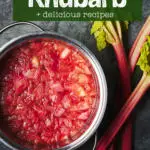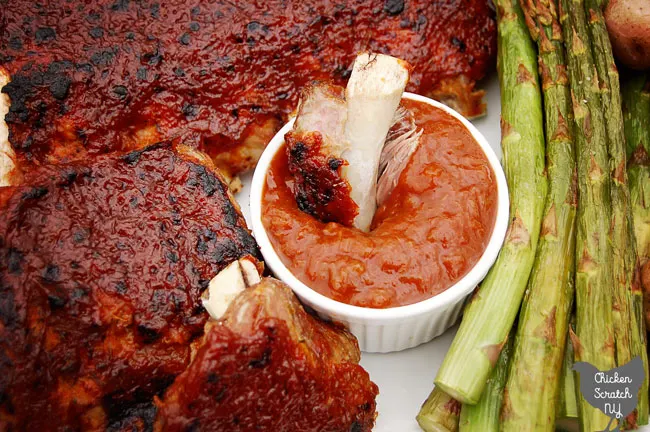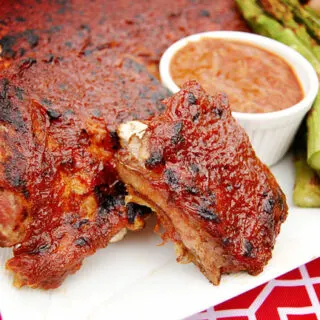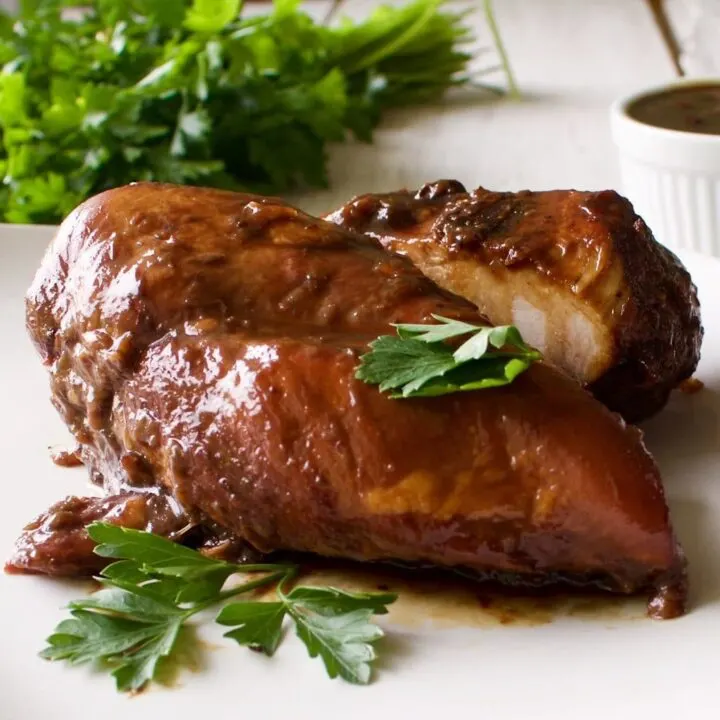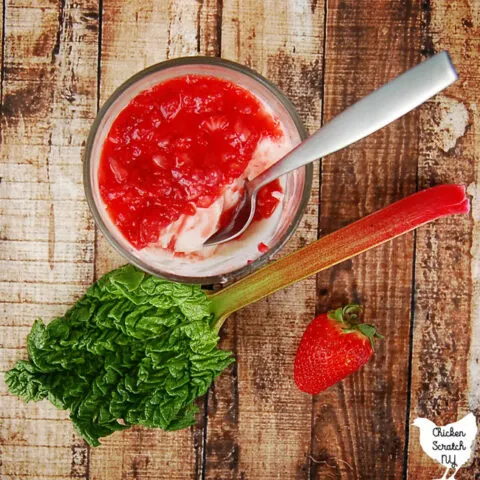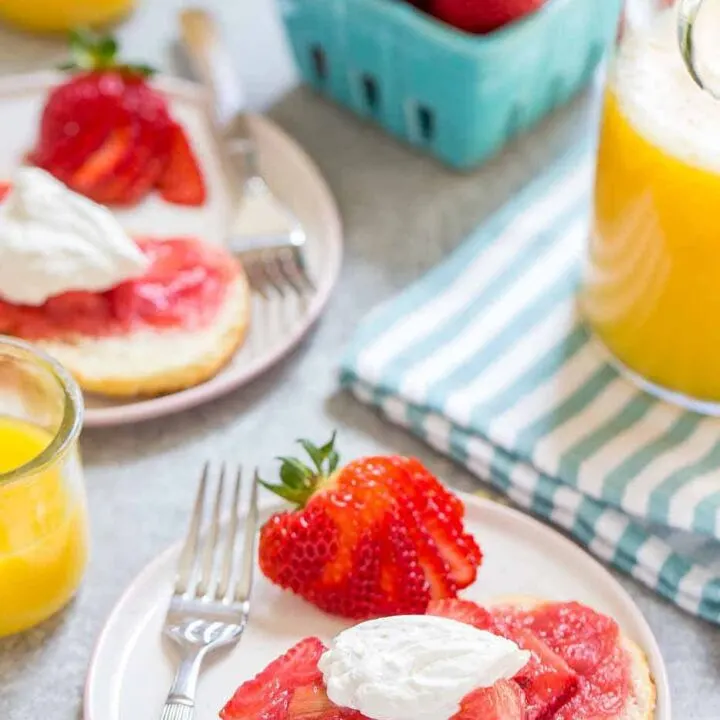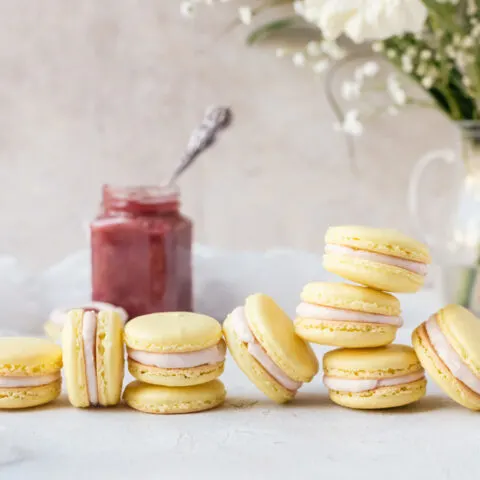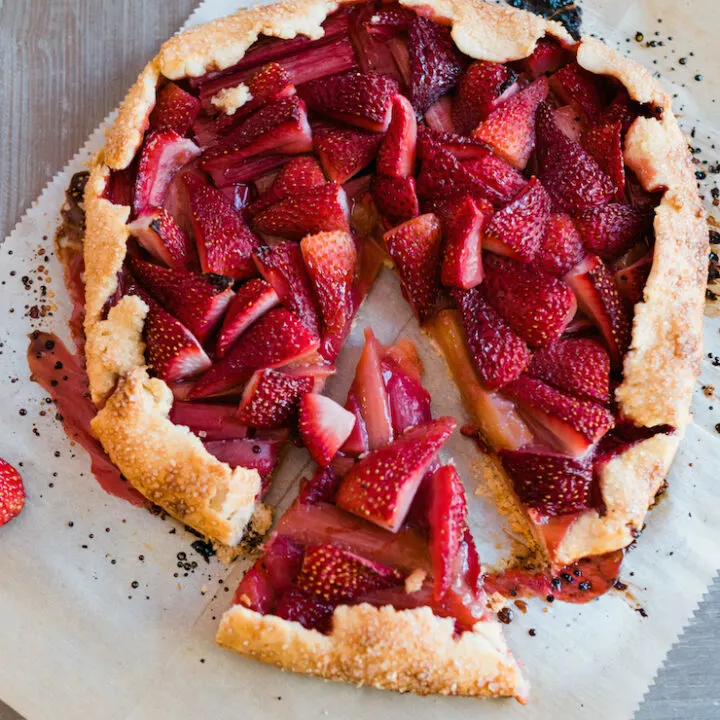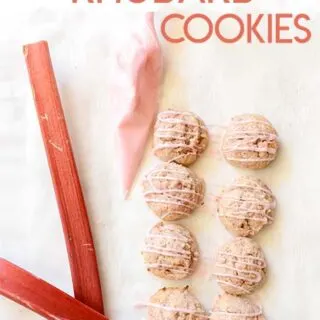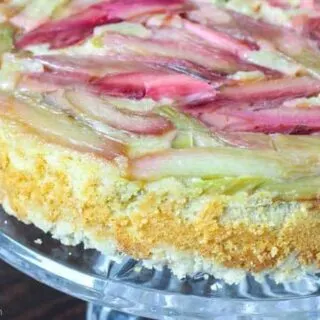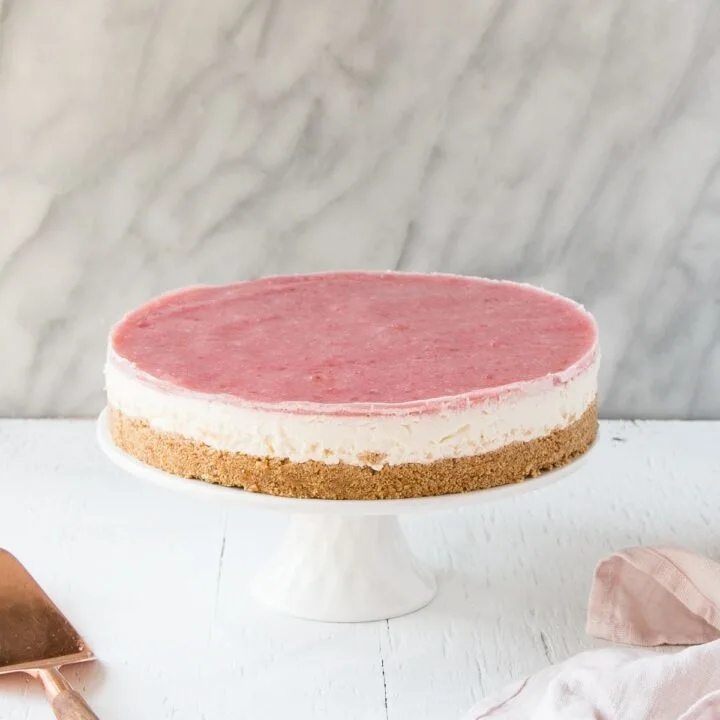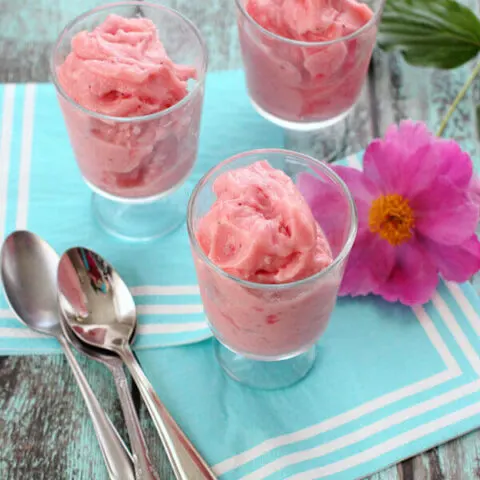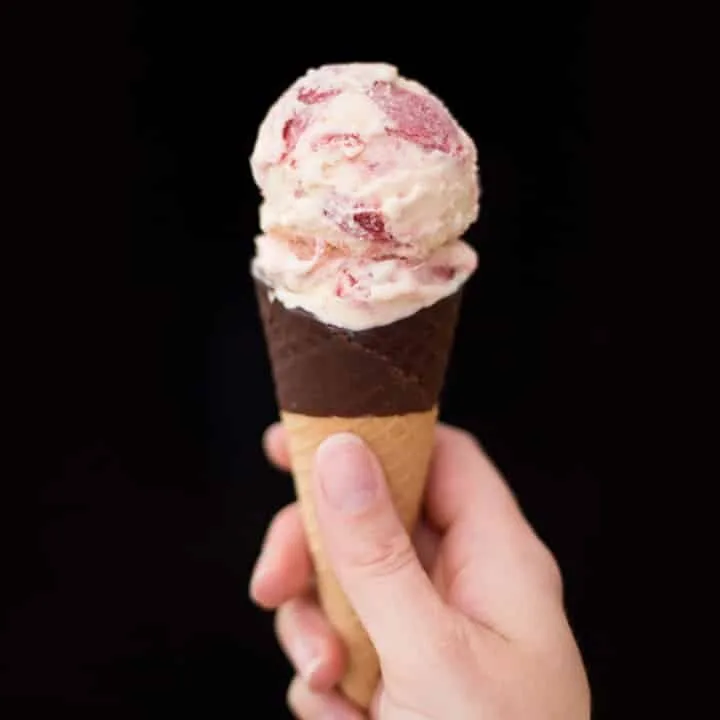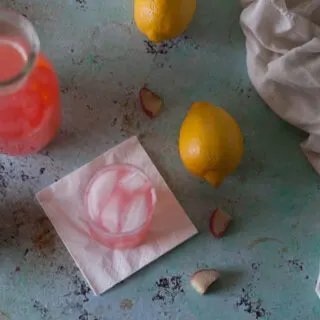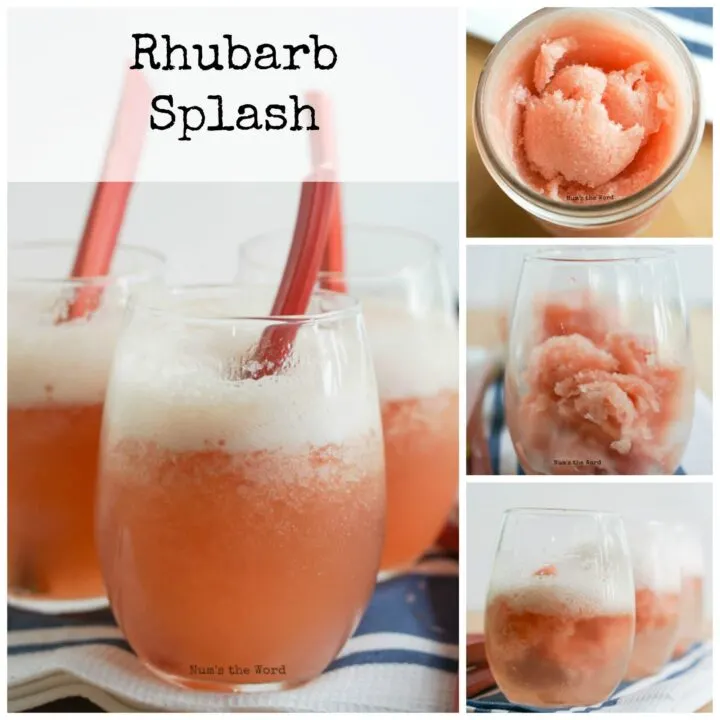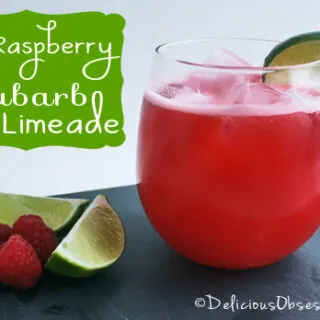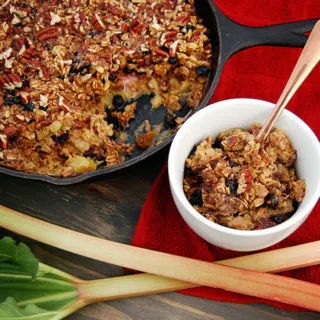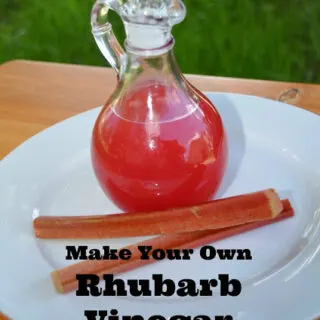It’s hard to beat Rhubarb for versatility in the kitchen. From sweet to savory or breakfast to dessert, there is a perfect rhubarb recipe to fit any situation.
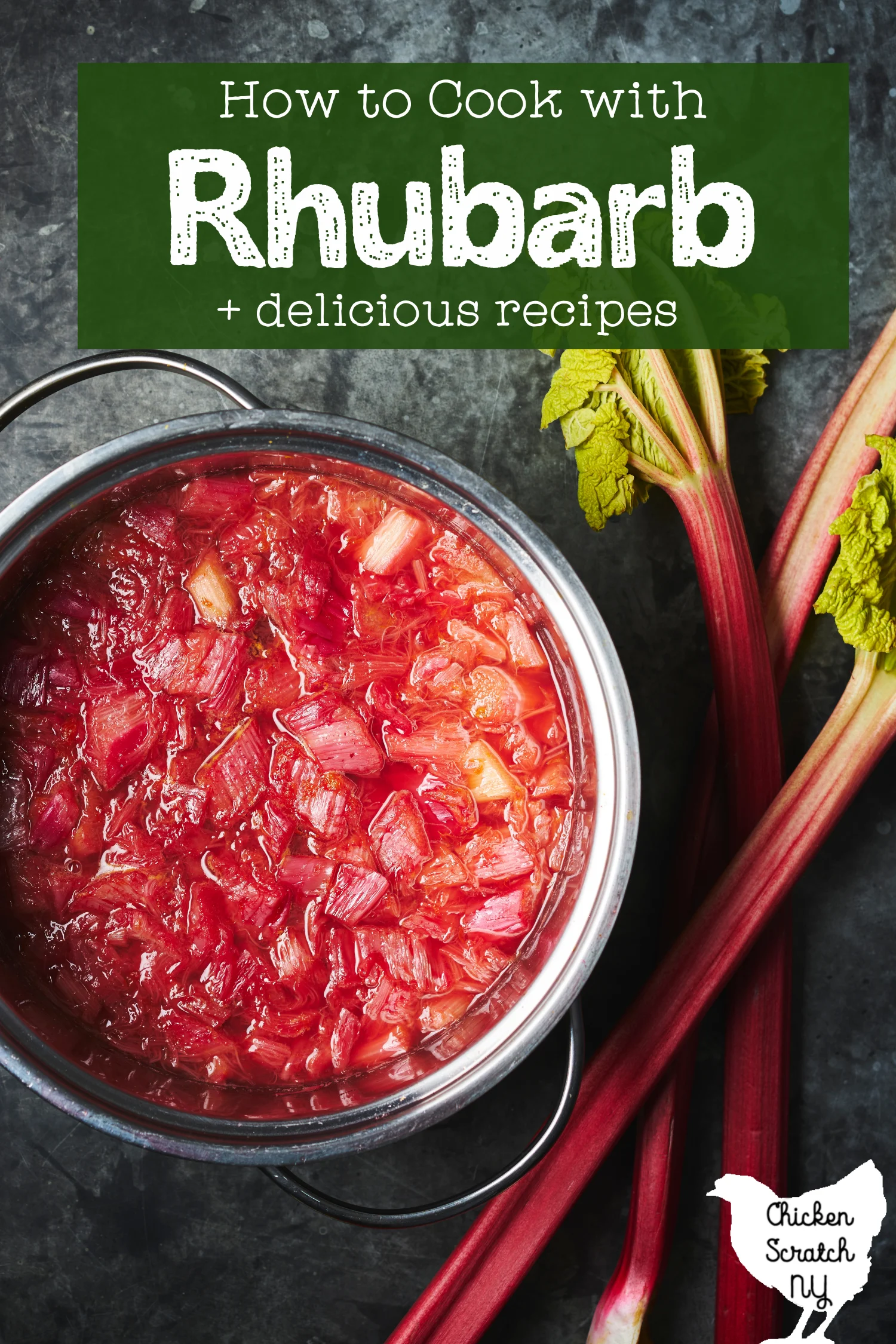
Rhubarb is a perennial vegetable that grows like crazy in cool climates. The tart stems come in green and red and can be eaten raw but are most often cooked.
Rhubarb is one of the earliest spring crops to harvest and its tart flavor is a popular foil to sweet spring strawberries. When it comes to eating rhubarb you’re after the thick stalks. In healthy plants those stalks can get really thick, some of mine are 2+ inches wide.
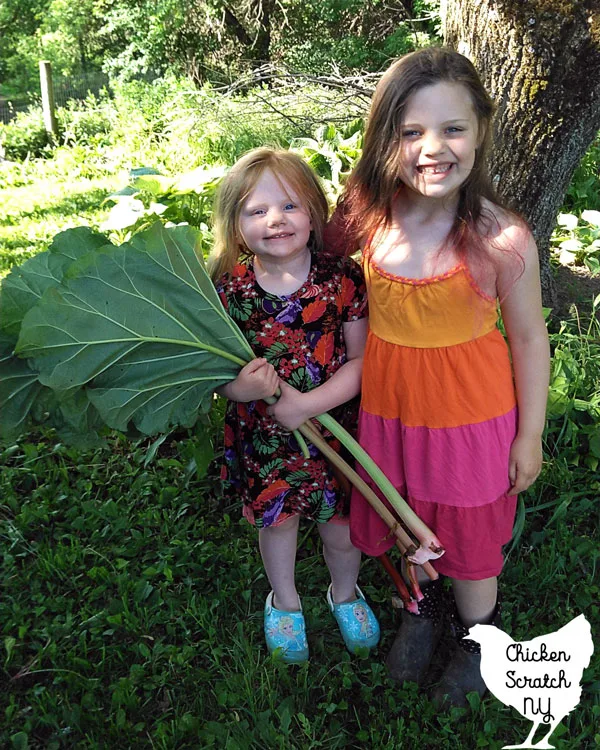
The leaves on the other hand are toxic, containing high levels of oxalic acid, and should not be eaten. It would take pounds of the leaves to reach a fatal dose so don’t let that stop you from growing this incredible plant.
Here in New York, we don’t even need to try to grow rhubarb, a bigger problem is using up all the deliciously tart stalks. Fortunately, rhubarb plays very well with others in recipes and the options are infinite.
Learn more about Growing & Harvesting Rhubarb
Every spring I eagerly await the unfurling leaves and red tinged stalks that practically leap from the cold, wet soil months before I can even think about plant my tomatoes in the garden.
That quickly turns in a rhubarb invasion in the kitchen. Which is great because it makes rhubarb easy to experiment with, with no guilt over kitchen failures.
Today we’re going to start out with my go-to methods to cook and preserve rhubarb and at the bottom, I have a huge list of rhubarb recipes from some of my favorite bloggers.
How to Cook Rhubarb
If I had to offer up a culinary comparison I’d say rhubarb is very similar to apples. Not in flavor, but in versatility. There are very few things you can’t do with rhubarb!
In general you’ll find rhubarb in two states, large chunks or in a sauce. Rhubarb has the magical ability to cook away into almost nothing but a smooth sauce with the addiction of heat and a little water.
Basic Rhubarb Sauce
You can make a simple rhubarb sauce to stand in for applesauce in a few minutes. As much as I love turning a bushel of apples into my no peel apple sauce this is 100x easier and it doesn’t require any fancy tools.
You’ll need a medium saucepan, a pile of cleaned and chopped rhubarb, a splash of water and sugar to taste. I never add a lot of sugar to my rhubarb sauce because I’m usually eating it on ice cream but it does help pull the water out the stalks.
Rhubarb can get a bit stringy so make sure to keep the slices under an inch in length. I try to go for 1/2 inch slices but like everything else in my life, it’s eyeballed.
Heat the rhubarb, sugar, and a big splash of water over medium heat. As the rhubarb heats up it will start to break down and release more liquid into the pan.
Keep it simmering and stir occasionally and after 15-30 minutes (depending on how much rhubarb you start with), you’ll have a nice, thick, and tart sauce on your hands.
If basic isn’t good enough you can add some flavor to your sauce with berries (BlueBarb is a favorite of mine), fresh ginger, or a vanilla bean. I also love mixing in a bit of orange zest at the end.
Or use it as the base to a tangy rhubarb barbeque sauce perfect for instant Pot Ribs and a spring cookout.
Rhubarb Juice
Making rhubarb juice is just like making rhubarb sauce but with an extra step.
Start by slicing up a whole pile of rhubarb stalks, you can leave the chunks larger than when you’re making sauce since we’ll be straining out the fibers.
Heat the rhubarb over medium heat with about 1/2 a cup of water. Cover until the water starts to simmer, occasionally stirring until the rhubarb breaks down.
Strain the rhubarb through a clean tea towel or through a mesh strainer making sure not to squeeze it. I know it’s tempting but it will release pectin and make your juice cloudy.
You’ll be left with pink rhubarb juice (even if you start with green rhubarb) and a pile of rhubarb mush. You can toss the mush to the chickens or eat it.
Sweeten the rhubarb juice to taste and enjoy it alone, like a tasty spring faux lemonade, or in cocktails like this Rhubarb Mimosa.
Baking with Rhubarb
The same magical properties the let rhubarb melt into a sauce comes into play in baked goods. The once firm chunks of rhubarb melt into soft pockets of tart fruit.

When that tart fruit is surrounded by sweet cake or even boring baked oatmeal? Heaven.
One important thing about rhubarb is that it is a very wet ingredient, and it gives off a lot of liquid as it cooks. Something to keep in mind if you’re doing your own experimenting at home by swapping out rhubarb for another ingredient.
Preserving Rhubarb
Even though rhubarb literally takes over in the spring time it’s a very seasonal ingredient. Depending on the weather we start harvesting rhubarb in late-April-May and keep going through late-June or Early-July.
When the weather heats up the rhubarb says peace out and that’s it until the next spring. Assuming you don’t eat so much rhubarb in that 10 week span that you don’t want to look at it for year, you’ll want to preserve some for future use.
The most common ways to preserve rhubarb are through freezing and canning.
How to Freeze Rhubarb
Freezing rhubarb is the most accessible way to preserve it. All you really need is freezer-safe containers and of course, a freezer.
Like most things, rhubarb will be very soft when you thaw it. It doesn’t matter if you’re going to make it into sauce or juice but might affect your baking.
There are two methods to freezing rhubarb, the ‘wet’ method, and the ‘dry’ method.
The Dry Pack Freezing Method
The dry pack freezing method is the healthiest, you won’t be adding any sugar or fruit juice. It’s all rhubarb!
Blanching rhubarb before freezing is optional but will give you the best results as far as flavor and color. You can blanch by dunking chopped rhubarb chunks in boiling water or steam blanch by placing the rhubarb in a steamer basket for 1.5 minutes.
After blanching (or not blanching) you can either freeze the fruit laid out on a cookie sheet for 2 hours before transferring to air tight containters (great if you want a gallon bag of rhubarb chunks for smoothies) or by packing the pieces of rhubarb into bags or containers and then freezing.
The second method will likely result in a big old hunk of frozen rhubarb, if you plan on using for a specific recipe freeze it in the appropriate amount.
The Wet Pack Freezing Method
The wet pack method of freezing rhubarb doesn’t require blanching, instead the chunks of rhubarb are frozen in jars or containers with added liquid.
While you can pack the rhubarb with water, it’s more common to use a sugar syrup, honey syrup or fruit juice. The added sugar makes the frozen rhubarb perfect for adding to deserts but might be out of place if you’re planning on making a more savory recipe.
For the wet pack method, combine clean chunks of rhubarb with either:
- Thin Syrup (2 cups sugar dissolved in 4 cups water)
- Medium Syrup (3 cups sugar dissolved in 4 cups water)
- Fruit Juice
- Honey Syrup (1 cup mild honey dissolved in 4 cups water)
Add rhubarb and cool liquid to freezer-safe containers leaving a 1/2 inch headspace in pint jars and a 1-inch headspace in quart jars. Free
Safety Note: Use Wide Mouth or straight-sided mason jars for freezing and leave adequate headspace (empty room above the food/liquid) to prevent jars from shattering due to expanding liquid
Canning Rhubarb
Rhubarb is a high acid food, making it a safe option for water bath canning. Water bath canning relies on the acidity of food to stop bacteria growth.
Pickles, jellies and jams that contain vinegar, sugar or high acid fruits are shelf-stable after being boiled in clean jars with canning lids. Waterbath canning can be done in any kind of pot as long as it’s big enough to cover the jars with boiling water.
The simplest way to can rhubarb is in syrup, toss 16 cups of rhubarb with 2-4 cups of sugar and let it sit for 3-4 hours to pull out the liquid. Bring it all to to a boil for 30 seconds. Reduce heat to a simmer, fill clean jars leaving a 1/2 inch head space and process in a boiler water bath for 15 minutes (for both pint and quart jars).
There are tons of modern, safe canning recipes for rhubarb, one of my favorites is the Sunshine Concentrate from The Ball Complete Book of Home Preserving. Check out that book along with my other favorite canning recipes books at your local library for more rhubarb recipes.
Interested in preserving the harvest? Check out my Favorite Canning & Preserving Books
Rhubarb Recipes
It's hard to beat Rhubarb for versatility in the kitchen. From sweet to savory or breakfast to dessert, there is a perfect rhubarb recipe to fit any situation.
Savory Rhubarb Recipes
Instant Pot Ribs with Rhubarb BBQ Sauce
Get fall off the bone ribs on your table in about an hour with your Instant Pot. Switch up the flavor with a homemade tart and savory Rhubarb BBQ sauce slathered on right before a quick trip under the broiler
Pan Fried Rhubarb Chicken
Pan fried Rhubarb Chicken is Low-Carb, Low-Sodium, Low-Sugar and Gluten-Free. This sweet and spicy chicken dinner makes a healthy springtime meal full of flavor and spice!
Chipotle Rhubarb BBQ Sauce (RhuBarb-ecue Sauce)
Elevate your summer grilling with homemade spicy chipotle rhubarb BBQ sauce, packed full of fresh rhubarb! Spicy, tangy, and just a little sweet, this barbecue sauce is the perfect use for your CSA and farmers market rhubarb.
Goat Cheese Crostini with Rhubarb Chutney
Tender goat cheese paired with tangy and sweet rhubarb chutney spread over fresh crusty ciabatta bread: the best goat cheese crostini ready in 10 minutes!
Rhubarb Desserts
Rhubarb Panna Cotta with Strawberry Balsamic Sauce
An easy but impressive summer dessert, this delicious rhubarb panna cotta is smooth and creamy with a tart bite. Topped with a strawberry balsamic sauce it's sure to impress
Strawberry Rhubarb Shortcake
Twisting up the classic by adding delicious rhubarb to bring out the season’s best. This Strawberry Rhubarb Shortcake is sweet, slightly tart and pairs perfectly with the homemade sugar biscuits and vanilla whipped cream.
Lemon Rhubarb Macarons
These sweet, tart lemon rhubarb macarons are the ultimate summery treat. It tastes like pink lemonade only much, much better.
Rhubarb and Strawberry Crostata
This super rustic dessert with hand folded edges is foolproof. It’s simple; it’s sexy, and absolutely delicious -- especially served with a scoop of vanilla ice cream.
Soft Rhubarb Cookie Recipe
Have Spring Rhubarb? Stop Everything and Make this Tangy and Soft Rhubarb Cookie Recipe
Rhubarb Curd
If you are a lemon curd fan, you need to make this rhubarb curd ASAP! It’s easy, delicious and crazy refreshing!
Rhubarb Upside Down Cake
Rhubarb isn’t just for pie, it’s for cake too! This summer take your rhubarb skills to the next level with this moist and delicious Rhubarb Upside Down Cake!
No Bake Rhubarb Cheesecake
Easy to whip up No Bake Rhubarb Cheesecake! A delicious make ahead no bake cheesecake dessert that pairs perfectly with wine. Plus, some tips for entertaining with wine.
Rhubarb Sherbet
With just 4 ingredients, this Rhubarb Sherbet is quick and easy to make. It’s naturally gluten free and can be made dairy free as well.
Rhubarb and Custard Ice Cream
This beautiful rhubarb and custard ice cream recipe is traditional, seasonal and absolutely divine! Perfect for Summer parties and dinner party desserts.
Rhubarb Drinks
Rhubarb Mimosa
Customize your mimosa by adding more rhubarb for a tart flavor or more orange for something sweet
How to Make Rhubarb Wine
If you grow a lot of Rhubarb, consider making some delicious wine with some of your harvest. It’s tasty and easy to make – here’s how to make Rhubarb Wine.
Rhubarb Pink Lemonade
This rhubarb lemonade is simple to make with a few stalks of rhubarb and about a half a dozen lemons.
Fermented Strawberry Rhubarb Soda
It’s spring and that means rhubarb and strawberries, a classic combination. Turn these fruits into fermented strawberry rhubarb soda and you have a real treat!
Rhubarb Splash
This Rhubarb Splash is a fruity, delicious drink perfect for a hot summers day. It’s sweet and has a 100% approval rating by everyone who has tried it!
Red Raspberry Rhubarb Limeade Recipe
This raspberry rhubarb limeade recipe hits the spot. The tartness of the rhubarb and lime is perfectly balanced by the sweetness of fresh raspberries.
Grandma’s Iced Rhubarb Tea Recipe
Looking for an iced rhubarb tea recipe? Learn how to make tea out of rhubarb for a delicious summer drink recipe made from rhubarb.
Everything Else
Rhubarb Baked Oatmeal with Blueberries & Pecans
Rhubarb baked oatmeal made with blueberries and pecans is the perfect way to start the day! Warm chunks of tart rhubarb, sweet blueberries and toasted pecans are right at home baked in a cast iron skillet with oats and spices
Homemade Rhubarb Vinegar
Make your own homemade rhubarb vinegar! This easy recipe is a great way to use up extra rhubarb. Use it on salads or to add flavor to cooking.
Check out my Recipes page for more ideas or start here:

